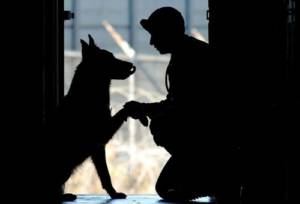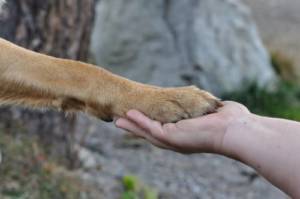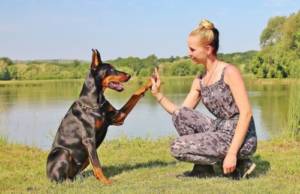Isn’t it cute when your dog does that adorable little routine of shifting their whole body weight to one leg, just so they could paw at you? You must have wondered why they do it and how did they come around to use this technique to demand attention/food/pets.
Our trusty friends are social animals much like humans, but their desire to be social is limited due to their restricted ability to communicate through their voices. Even though they may be loud and crisp, barks do not make for an effective and clear communication channel. So, they have evolved to use a tact that makes it easier for the hand-centric humans to understand what their fur-baby demands from them by using their substitutes for hands – paws.
Even though a paw may just mean one thing to you, how the dog uses it is relevant to what they want you to know. Whether they paw at you repeatedly, use their paws to hold you, or just simply put it on your leg – they all say different things to you. We’ll help you understand why your dog may be using their paw on you, just read on.
-
Returning Affection
Your pups feel a range of emotions just like you do and affection is the primary emotion that is mutual for both sides in this relationship. So while you can sing songs, talk in cute voices and pet them, the most a dog can do is pet you back! Your pets and cuddles are returned by them in forms of physical affection of their own – like putting their paw on you while you pet them.
So, the next time you pet your dog, notice if they want you to feel the same way. But don’t worry if the paw-pet does not always happen, after all, every dog may have their way of showing you they love you. Whether it’s play-biting or pawing, every dog treated with affection will always have love to give.
-
Playtime
This one is usually the easiest to decipher. Your pup puts their paw on you, with hopeful light in their eyes, pointed ears and a happily wagging tail. Dogs are highly energetic and creative beings. Their need for physical and mental stimulation surpasses yours easily, as while you’ve got the whole world they only really have you.
Dogs, like other pets, have needs that need to be met. If your dog puts their paw on you while pointing towards your play area, bouncing around after pawing you then that means they’re asking you to get up and play with them. A more obvious tell would be if they bring a toy to you, but you’d get that without our help anyways.
It’s also relevant to see when does this behaviour usually occur. Does your dog always paw you before playtime? If so, the behaviour may have been reinforced by you responding and playing with them in the past.
-
Demanding Attention
While you may be busy completing your very important tasks, it is necessary to remember you’ve got an adorable friend who has their own needs to be fulfilled. Instead of barking or causing a ruckus when they feel neglected, a lot of dogs use the polite method of putting their paws on you to ask you to give them their fair share of pets and attention.
If this is accompanied by puppy-eyes and resting their chin on your knee or shoulder, they definitely need some good loving. Keep in mind, however, that if you respond with affection every time your dog puts a paw on you, they may develop a habit of overusing this trick which can turn from cute to annoying really quickly. So make sure you set boundaries with your pet which will help them in being disciplined and well-behaved.
So the next time your dog shoves their paw into you, give them a good head scratch for us.
-
Saying Sorry
No matter how well-trained your dog might be, they’re still animals with instincts and centuries-old traits. They’re susceptible to the odd mistake now and then. After you’re done reprimanding them and teaching them a lesson, they may feel bad for their actions. This is precisely why you’re scolding them.
The punishments you give to your dogs reinforce the kind of behaviour that is encouraged and the dog’s guilt may surface in the form of a subdued paw on your knee.
After a good telling-to, your pet may come to you with their tail tucked between their legs and a raised paw to say they’re sorry! This is a moment to reassure them and make them feel less anxious about disappointing you. Let them know they’re still loved. This will help in your effort to discipline them while still nourishing the special bond that you both share.
-
Seeking Support
Dogs are empathic creatures who ask for nothing but your affection and support. They can sense when you’re down or stressed from your body language and try their best to lift your spirits. It is only fair that you return the favor.
Dogs may experience distress in the form of social anxiety, separation anxiety or thunderstorm anxiety where dogs get anxious and scared from the loud noises that a thunderstorm brings. These are highly stressful events for dogs and they may respond accordingly. For instance – when you get up to leave at the usual time of the day, a dog with separation anxiety may put their paw on you to ask you to not leave.
In this way, dogs seek support from their caretaker by gently requesting their support from a paw on your knee.
-
Demanding Food
You’re sitting reading your favorite blog when you suddenly feel a light tap on your leg. It’s your four-legged friend moving back and forth while pawing you continuously. You check the clock and the hands point to feed’o clock.
Just how does your dog always know it’s time for dinner is beyond you, but they make sure to remind you with the consistent tapping.
It is one of the easiest signs to get, as it is mostly around the time you feed your dog or is usually accompanied with other body language signs such as cribbing, an open mouth and a little urgency. As always with such needs, it is important that your pup must not get used to this mechanism.
Keep in mind, if you frequently respond to the dog’s pawing, they may get used to asking for food on-demand with no regard for time or place. Thus, make sure you set boundaries with your dog’s actions and your responses to them.
-
Other Needs
Of course, your dog isn’t all love and food. They have other needs that need tending to as well. Their go-to action of putting a paw on their caretaker has worked well up to now, so they don’t hesitate to use it to let their owner know about their needs. A dog may put their paw on you to ask you to take them out on a walk, so they can go to relieve themselves outside.
They may be using it to bring your attention to something they’ve discovered or are concerned about. If a dog puts its paws on you and pretends to go somewhere, maybe it’s best to follow them and see what they have to show to you. They may have made a mess that needs cleaning up or brought something for you as a gift(which may need cleaning up too).
-
Pain
One of the most obvious signs of discomfort is when your dog is telling you about it themselves. A dog may put their paw on you to bring attention to the pain and discomfort they may be experiencing internally or externally. Since they have known you to be a solver of problems, they expect you to get rid of it. Why wouldn’t they? You’re their only hope!
Your friend needs love and care at this moment of weakness, so make sure you respect your part of the deal. A pup in pain may refuse food, playing and show visible signs of discomfort. If you think they’re giving you a signal, then they probably are. Get them to a vet to make sure they’re healthy and fit.

Understanding Pawing in Context
Look For Patterns
Since there are only so many ways a dog can use its paws, you must understand the time, places and behaviours associated with the range of demands of your furry friend. By paying enough attention to your pup and its demands, you can predict and even prevent the behavior.
For instance, if your puppy keeps using its paw around the time you take them out for their walk daily, it might be best to teach the pup to stay by the door and wait for you rather than keep up the habit.
How To Discourage Pawing?
It might be cute at first, but we’re sure it would be tough to not get annoyed by the constant poking and pawing. You’re allowed to have your reservations about hygiene too, given most dogs don’t wear shoes. A lot can get stuck under their feet and dirty your shiny clean clothes, or worse tear them!
It’s recommended that pawing be discouraged as enforcing this behavior would mean being bombarded with paws any time you’re available. If you respond to every poke and demand, it would be exhausting by every means.
There are ways to be done with it, without being rude at all.
First, you can discourage any pawing by not responding and ignoring any cries for attention whenever your dog tries to grab your attention using this. Once they know that it’s of no use, they’ll eventually stop.
Second, it’s important to be consistent with your behavior as dogs can easily get confused by even one moment of attention. It’s important to never respond to them if you want to discourage the behavior permanently.
Finally, the owner can make sure that the dog’s needs are fully met and that they aren’t hungry, sick, or in need of assistance.
Body Language

Body language can help identify the type of behavior that the dog may be showing, as a simple paw can mean a lot of things. Dogs can exhibit a wide range of communication signals to go with the pawing, such as their ears, tails, eyes and body as a whole.
Playful Mood – The dog will paw you and look directly at you. An excited dog always has a wagging tail and a highly energetic body looking for a sparring partner. If your dog comes up to you with excitement and paws you, you better brace yourself for a game of fetch.
Affectionate Mood – Dogs have a very calm and gentle way of demanding affection. If they crave some good old lovin’, they’ll come in a relaxed manner, with a soft gaze looking at you lovingly. In this case, just a few scratches and pets will do.
Anxious and Distressed – A pup in discomfort will be easy to spot with upright ears and frantic pacing around the place to accompany the pawing that is primary. The puppy may look at you but will not maintain the gaze if they aren’t at ease. It would be best to take the puppy to the vet in that case.
We hope you found what you were looking for. Do you have an answer for your dog’s behavior with you? Is there anything we missed or anything you think might add to it? Let us know in the comments.
Source –
https://www.canidae.com/blog/2015/05/how-dogs-use-their-paws-to-communicate
